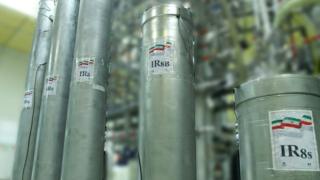 Image copyright
Image copyright
Toronto Star via Getty Images
Toronto is one of North America’s largest cities
Social media platform Instagram has unveiled a potential new change to its software – but perhaps unsurprisingly – it has chosen Canada as the proving grounds for this experiment.
The social media company said it plans to hide the number of likes on photos and videos from public view.
Only the person who made the post will know just how many people liked it – a move Facebook, the tech giant that owns Instagram, says is meant to get people to focus on the actual content shared and not just its popularity.
Facebook says Canadians are highly social and tech savvy, noting there are over 24m people using a Facebook-owned app each month in the country.
This is not the first time that Facebook – which also owns WhatsApp and Instagram – has tested products in Canada.
Image copyright
Courtesy Facebook
Get used to this, Canada
Last year, along with Colombia and Thailand, Canadians were given early access to the firm’s early foray into online dating -simply called Facebook Dating.
And in 2017, its first foray into providing advertising transparency was in Canada.
But the social media behemoth isn’t the only company that has found value in using Canada as a place to show proof of concept for new products and innovation before bringing them to wider markets.
Image copyright
PA
Facebook is testing ‘likes’ in Canada
Global developers frequently use the country as a testing ground for new apps.
“The data you get there is reliable and comparable to the other major markets – the US, the UK, Denmark and so on – and the country is also of a good size,” a gaming executive told tech media company Mashable in 2013.
Robert Levy, president of BrandSpark, a Toronto-based market research company, says launching new innovations and evolving technology is “the lifeblood of brands and what consumers expect in a hyper-competitive marketplace”.
And he says Canada is “a very, very sophisticated marketing environment” and a “compact way to get a lot of bang for your test buck”.
So what makes the country attractive for firms looking to refine products and services before bringing them to a wider market?
‘It’s really about diversity’
“In Canada we have really a very diverse population with more than 200 languages spoken throughout the country,” says Danny Heuman, chief analytics officer with market research firm Environics Analytics.
It’s not just the immigration factor – it has the highest proportion of foreign-born people of any G7 nation – but its cross sections of people across the income spectrum and from urban and suburban regions.
Together they compose a wide range of consumer segments and demographic niches in which to test and learn.
Image copyright
Reuters
Panasonic Canada has used the country as a test market for new products
Michael Moskowitz, president of Panasonic Canada, has championed Canada as a place for global firms to test new products or to refine existing ones.
But, he says not all firms have grasped Canada’s potential, because some see the country as a small secondary market, with only about tenth of the population of its wealthy southern neighbour.
But others view it as a test bed for new technology or ideas “with fairly low risk” that, if successful, can be launched in the US and beyond, says Mr Moskowitz.
“Canadians are very entrepreneurial and nimble,” he says, adding that Panasonic Canada is able to “make fairly quick decisions locally”.
But that diverse population is among the “standout reasons” that make Canada a useful laboratory, says the Panasonic executive.
‘Like the US, but not like the US’
Most Canadians live within 100 miles (160km) of the US border, a proximity has leant itself to a lot of social and cultural overlap.
Mr Heuman says Canadians will have similar tastes to Americans when it comes to things like media, pop culture and foods. And it’s just as wired as the US with a similar technological infrastructure and with most residents owning smartphones.
“So when you talk about technology like with Instagram, we are very similar in our behaviours,” he says.
On the consumer side, Panasonic has tested small format appliances in Toronto, which is one of North America’s largest cities and where a lot of residents live in apartments or condominiums, similar to living quarters in large cities in both Canada and the US.
“Just in terms of our proximity to the US, the similarities, Canada becomes a natural launch-pad for organisations looking to make inroads into the North American market,” says Mr Moskowitz.
But the US’s northern neighbour is also useful for global brands seeking out market research for new ideas because the country can also be reflective of consumers in Europe and elsewhere.
“I do see Canada being more reflective of the world than the US, for example,” says Mr Heuman.
“Canada seems like a logical place to go because we are like the US but we are also like Australia, we are like the UK, we’re still a little bit like Germany, we’re still a little bit like Sweden and Norway and other countries like that.”
Geographic diversity
A number of global companies have Canadian outposts in large cities like Toronto, Montreal and Vancouver.
Mr Heuman says those cities and their suburbs are valuable for firms looking for regions in which to conduct research, with lifestyle and commutes comparable to major American cities like Los Angeles and Atlanta.
But Canada also has a vast rural territory with a wealth of geographic diversity.
Image copyright
NurPhoto
Cars have to be able to perform even in conditions like these
Mr Moskowitz says there are numerous testing centres for massive industries like automotive and aerospace where innovative products can be tested in weather extremes.
Firms like Toyota, Hyundai and GM have all tested vehicles in Canada, along with countries like Sweden, Russia, China and in parts of the US.
Thompson, Manitoba, is home to a centre that provides ice tests for aerospace engine certification programmes that was built in partnership with Rolls-Royce and Pratt & Whitney.
Yellowknife, in Canada’s Northwest Territories, is working towards being recognised by global aerospace firms as an arctic cold weather testing destination.
Panasonic has also taken advantage of the extreme weather in Canada, partnering in 2011 with two First Nations tribes, the Yukon government and a northern research centre on a successful pilot project that tested vacuum-insulated refrigerator panels as home insulation.
The panels, which can help reduce energy costs, are now used insulate homes in extremely cold climates.












